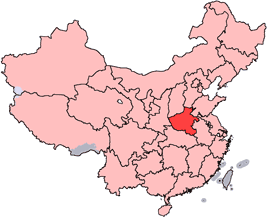India, China to jointly construct Buddhist temple in Henan Province
Monday, April 18, 2005

Wikipedia GFDL image
The governments of India and China have declared in an official memorandum on April 11 their intention to jointly construct an Indian-style Buddhist temple on the western side of the historic White Horse Temple, in Luoyang, Henan Province, China. The project is planned as part of an ongoing effort to increase the ties of friendship and shared culture between the two countries.
The memorandum came in a series of agreements between Chinese Premier Wen Jiabao and Indian Prime Minister Manmohan Singh, during Jiabao's state visit to India April 9-12 at Singh's invitation.
India is expected to provide the funding, architectural design, landscape planning, a Buddha idol and other materials for the completed temple. China is offering to provide official cooperation and permits, and facilitate the travel of Indian architects and other construction experts to the site. The temple is planned to be located on 2,667 square meters of land provided by the Chinese government.
White Horse Temple
editThe site of the newly announced temple is said to be in the International Garden of the White Horse Temple in Luoyang.
The White Horse Temple is a site of historic importance to Buddhism. Constructed almost 2,000 years ago in AD 68, the temple is the location first used to introduce Buddhism to China from India. Two Buddhist monks from India, Kasyapa Matanga and Dharmaranya, are said to have originally resided there.
Luoyang, Henan Province
editLuoyang, one of China's seven ancient cities, is located in the central plain of China in the valley of the Yellow River. The Longmen Grottoes (or Longmen Caves), another historic site containing thousands of Buddhist sculptures, are located a few kilometers south of there.
Henan Province is located in east-central China, as shown in the above map. It is China's most populous province, with over 96 million residents, mostly Mandarin-speaking Han Chinese. According to Wikipedia, it is traditionally considered to be the source of Chinese civilization.
India-China relationship
editMany aspects of the India-China relationship were discussed during the official visit. These include:
- Discussions of military cooperation, including contacts and exchange of views of high level military officials, such as the current visit of Indian naval Vice Admiral Yashwant Prasad to China during April 11-19, and other naval activities such as the docking of ships. Both India and China are nuclear-armed nations.
- Pushing forward toward mutual agreement on defining the geographical boundary between China and India, called the Line of Actual Control (LAC). The two countries have been unsuccessful in their attempts to resolve their dispute since the Sino-Indian border war of 1962, subsequent decades of military friction and official protests in the 1980s, and peacemaking efforts in the 1990s.
- Trade and economic cooperation between the world's two most populous countries to be increased from the equivalent of US$13.6 billion last year to US$20 billion annually by 2008, and the two governments are studying the benefits of a possible India-China Regional Trade Agreement. China is said to be particularly strong in manufacturing, which complements India's growth in the IT software and services sector.
- The Tibet Autonomous Region was again recognized to be part of Chinese territory by India, under its long-standing "One China" policy; and India's policy continues to be "that it [does] not allow Tibetans to engage in anti-China political activities in India". Since the Dalai Lama fled Tibet in 1959, India has played host to the exiled Tibetan government in the town of Dharmsala in the Himalayan Mountains.
- Many areas of future exchange and reciprocity, including anti-terrorism, scientific exchange, academic, technological, financial, shipping, tourism, film-making, sports, water management, and shared oil and gas exploration in other countries. China is currently the world's third-largest oil consumer, behind only the US and Japan, and its appetite for oil is quickly growing.
Leaders of the two countries have declared 2006 to be the "year of India-China friendship" and will be undertaking other cultural exchanges in furtherance of what they call "principles of Panchsheel", or peaceful coexistence. Modern diplomatic relations between the two countries were established 55 years ago after the founding of the People's Republic of China in 1949.
India is also currently working on strengthening its relations with the United States, with a current visit to the US by Singh, and a planned visit to India in 2005 by President George W. Bush.
Sources
edit- "Editorial: Mr. Wen courts India" — Japan Times, April 16, 2005
- "India to build Buddhist temple in China" — WorldWide Religious News/Indo-Asian News Service, April 15, 2005
- "India to build Buddhist temple in China" — WebIndia123, April 15, 2005
- "Bush 'excited' over India-US ties" — BBC News, April 15, 2005
Press Releases
editRelated Stories
edit- April 5, 2005: India-China border talks resume
- April 4, 2005: India and China to discuss energy: cooperation or competition?
- March 28, 2005: India may rise as regional power
External links
edit